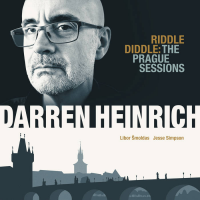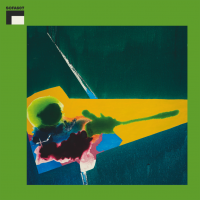Home » Jazz Articles » Album Review » Adam Linson: Figures and Grounds
Adam Linson: Figures and Grounds
Linson says that his role in bringing this group together was to provide a new context for the diverse talents of the musicians. From the outset, the aim of the group was to explore the range of possibilities at the intersection of jazz and computer music. As on his two previous Psi albums, Cut and Continuum (2006) and Integument (2009), Linson is interested in manipulation, real-time signal processing, time-delayed sampling and layering. The details of what that actually entails need not be of further concern, but Linson found a kindred spirit in Dörner, who had his own electronics and processing setup. Mahall and Lytton played it straight, being sampled and processed along with everything else.
The end result is a multilayered soundscape that includes the sounds of live playing plus samples of earlier playing processed or unprocessed. Linson reassuringly states that no synthesis or prerecorded samples are used in the music here—every sound stems from within the session. But some sounds were subjected to such transformations that they appear entirely untraceable to their source, even when listened to by the musicians who produced them. One such sound occurs some five minutes into the opening track, "Swamp Delta to the Sky," when the aural evidence suggests that a wild beast has entered the studio and is roaring fiercely at the musicians; they display no obvious signs of dismay or panic, so the sound must be the processed sound of an instrument. Phew!
Leaving aside such contributions from the invisible fifth member—the electronics—the four players deliver a vibrant, free-flowing session. Other than acting as random elements, as above, the processed sounds form a backdrop to the live playing as well as introducing stimuli to which the live players react. Interestingly, even when Linson and Dörner's contributions do occasionally sound rather over-processed, the sounds of Mahal's bass clarinet and Lytton's percussion remain clearly audible and form the skeleton of the music, giving it shape and structure. Even amidst the many sounds of dubious origin, the individual trademarks of each of the players are still clearly distinguishable.
Linson's aim to explore the range of possibilities at the intersection of jazz and computer music goes some way to being achieved; it still feels as if there are yet more possibilities to be explored. As an exemplar of the use of electronics and processing with a small improvising group, Figures and Grounds is a great success.
Track Listing
Swamp Delta to the Sky; City Dissolved in Light; Invisible Mornings.
Personnel
Axel Dörner: trumpet, electronics; Rudi Mahall: bass clarinet; Adam Linson: double-bass, electronics; Paul Lytton drums, percussion.
Album information
Title: Figures and Grounds | Year Released: 2011 | Record Label: Psi
Tags
PREVIOUS / NEXT
Support All About Jazz
 All About Jazz has been a pillar of jazz since 1995, championing it as an art form and, more importantly, supporting the musicians who make it. Our enduring commitment has made "AAJ" one of the most culturally important websites of its kind, read by hundreds of thousands of fans, musicians and industry figures every month.
All About Jazz has been a pillar of jazz since 1995, championing it as an art form and, more importantly, supporting the musicians who make it. Our enduring commitment has made "AAJ" one of the most culturally important websites of its kind, read by hundreds of thousands of fans, musicians and industry figures every month.

















